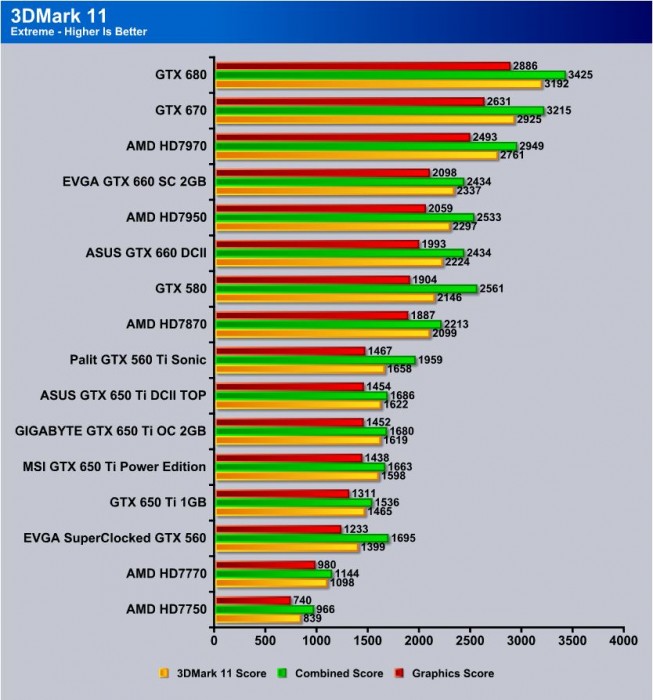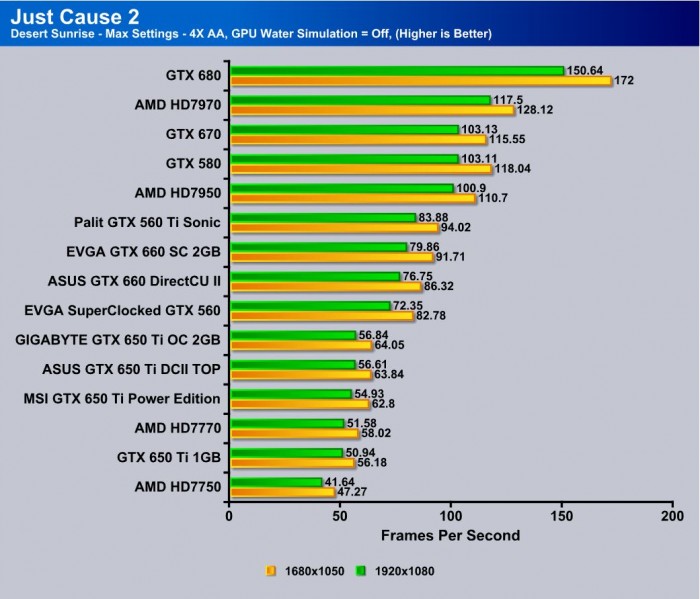ASUS GeForce GTX 660 DirectCU II
Testing & Methodology

We’ve expanded our testing suite considerably since the X79 chipset release, and will continue to use the same methods for most of the motherboards and CPU’s we test. In the interests of thoroughness and accurate results, we run each test at least three times, and some tests more than that. We average the total of all the tests from each benchmark then report the average here.
The OS we use is Windows 7 Pro 64bit with all patches and updates applied. We also use the latest drivers available for the motherboard and any devices attached to the computer. We do not disable background tasks or tweak the OS or system in any way. We turn off drive indexing and daily defragging. We also turn off Prefetch and Superfetch. This is not an attempt to produce bigger benchmark numbers. Drive indexing and defragging can interfere with testing and produce confusing numbers. If a test were to be run while a drive was being indexed or defragged, and then the same test was later run when these processes were off, the two results would be contradictory and erroneous. As we cannot control when defragging and indexing occur precisely enough to guarantee that they won’t interfere with testing, we opt to disable the features entirely.
Prefetch tries to predict what users will load the next time they boot the machine by caching the relevant files and storing them for later use. We want to learn how the program runs without any of the files being cached, and we disable it so that each test run we do not have to clear Prefetch to get accurate numbers. Lastly we disable Superfetch. Superfetch loads often-used programs into the memory. It is one of the reasons that Windows occupies so much memory. Vista fills the memory in an attempt to predict what users will load. Having one test run with files cached, and another test run with the files un-cached would result in inaccurate numbers. Again, since we can’t control its timings so precisely, it we turn it off. Because these four features can potentially interfere with benchmarking, and and are out of our control, we disable them. We do not disable anything else.
We are revamping our testing method in order to better represent motherboard performance and offering to the consumer. Also we want to make it an easier read for you without miles of endless charts. We ask that you provide feedback in an effort to help us deliver better reviews for you.
Test Rig
| Test Rig | |
| Case | Thermaltake Level 10 GT |
| CPU | Intel Core i7-3770K |
| Motherboard | ASUS Maximus V Gene |
| Ram | 16GbpsB Patriot Viper Xtreme 2400MHz + |
| CPU Cooler | Swiftech H20-220 Edge |
| Hard Drive | Western Digital Velociraptor 300GB |
| SSD | Intel 510 series SATA III 120GB |
| Optical | ASUS BD-ROM |
| GPU | ASUS GeForce GTX 660 DirectCU II |
| Additional Cards |
N/A |
| PSU | Thermaltake Toughpower XT 1275W Platinum |
| Mouse | Tt eSPORTS Black gaming mouse |
| Keyboard | Tt eSPORTS Meka G1 mechanical gaming keyboard |
Test Suite
We will use the following applications to test the performance of the graphics card.
Synthetic Benchmarks & Games
| Benchmarks |
|---|
| 3DMark11 |
| Heaven Benchmark 3.0 |
| Batman: Arkham City |
| Just Cause 2 |
| Lost Planet 2 |
| Dirt 3 |
| Metro 2033 |
Overclocking

The ASUS GeForce GTX 660 DirectCU II cooler and SAP components combine every time to make for a great overclocking experience. This is no different with the GTX 660 as the slider keeps moving to a final stable clock of 1135MHz which is quite good at about 15% overclock.
The memory was similar as default is already past 6GHz frequency but the card easily clocked past 6800MHz to a final stable frequency of 6840MHz which is a sizable 13% overclock.
These overclocks are completely stable across game testing and benchmarks and while the card may pull a little further for short benchmark runs this is the max we could get to be considered fully stable. This could easily enable a few extra frames and give a much smoother gameplay for a gamer who might have been on the edge previously. This and the fact that I’ve never been one to complain about free performance so i’m not gonna start now.
| Clock | Stock Frequency | Max stable MHz |
OC Percent |
| GPU Base clock | 980MHz | 1135MHz | 15% |
| Memory clock | 1502MHz (6008MHz) | 1710MHz (6840MHz) | 13% |
In order to ensure no system bottleneck we clocked the CPU to 4.6GHz to ensure there is no reason the system will slow down the cards performance at all.
Some may ask why we chose the mainstream Z77 system, and we can explain. Up until recent the X79 enthusiasts platform did not really support PCI-E Gen 3 on the Nvidia 600 series GPU’s. Because of the inherent instability many have seen with the X79 platform with Gen 3 products, Nvidia has been hesitant to enable it, and now there is a workaround via registry to get it working. However, in order to ensure the most consistent testing possible, we have stuck to the natively supported Z77 platform.
Important note: Overclocking can cause component failure. Please exercise caution when attempting any level of overclock on system components.
Temperatures

The temperatures were recorded with full loaded Heaven benchmark looping for over 30 minutes or longer depending how long it took for the card to level out in temps and sat at a plateau for more than 10 minutes.
| GPU Temperatures | Temperature (Idle/Load) |
| ASUS GeForce GTX 660 DirectCU II OC | 31C/65C |
| ASUS GeForce GTX 660 DirectCU II | 31C/63C |
The DirectCU II cooler worked excellently as the fans stayed nice and quiet throughout the runs and even when overclocked it swallowed up the heat and kep chugging along without issue.
Real world/Gaming Benchmarks
3DMARK 11

3DMark 11 is the newest in Futuremark’s suite of benchmarking utilities. Its a fully capable DirectX11 benchmark which also stresses and analyzes the system performance as a whole to simulate a heavy rendering environment such as a high end game or other app the end user may run. This benchmark was run with Performance settings 5 times and all runs were averaged for the result below.
3DMark 11 shows a nice picture of where each card falls in line coming from our testbench. The GTX 660 DCII falls right in line above the 650 Ti and below the 580 in the performance preset. The extreme preset lets the 660 DCII’s 2GB of frame buffer shine as it pulls ahead of the 1.5GB 580 and further distances itself ahead of the 650 Ti.
Unigine Heaven 3.0

Unigine Heaven is a benchmark program based on Unigine Corp’s latest engine, Unigine. The engine features DirectX 11, Hardware tessellation, DirectCompute, and Shader Model 5.0. All of these new technologies combined with the ability to run each card through the same exact test means this benchmark should be in our arsenal for a long time.
Here we see once again the 660 DCII jumping ahead of both the GTX 560 and 650 Ti and nothing in just on the heels of the 580 which is not a bad place to be as this card is roughly half the price of the 580 at launch.
Metro 2033

Metro 2033 has always been extraordinarily stressful for GPU’s, and this has not changed with time. Here you can see the ASUS 660 offering actually creeping very close to the EVGA SC card by just a a frame at 1680×1050 and even less at 1080P which is not bad at all and I can imagine with the overclock the ASUS card could easily jump up even more.
Lost Planet 2

Lost Planet 2 shows a definite trend here as the 660 DCII hangs right in position just nipping at the heels of the previous gen flagship 580 and well ahead of one of AMDs premier performers the 7950! This little 660 is proving to be a real winner in teh price for performance category.
Batman: Arkham City

We tested Batman Arkham City and once again the 660 DCII finds itself in a power position actually beating out the 580 by a decent margin with over 15 FPS difference and that is quite alot for a card of this pricing and position.
Just Cause 2

I just had to test Just cause 2 as it is an awesome game with some very good visuals. The 660 pulls off a respectable performance but this time it falls a bit behind the 580 and even the previous gen 560 Ti as it seems this game is very friendly to the older architecture. But even with this considered the 660 pulls of a nice showing with very playable frame rates in excess of 60 FPS average which means it should be nice and smooth.
Dirt 3

Dirt 3 is a great game for visuals and yet pulls very reasonable framerates on most cards so the 660 DCII pulls over 60 easily. and beats out the 560 Ti this go around but is at the heels of the 7950 and 580 this time. This is not bad company to have as these are top level GPUs and that means this is one excellent performer.
 Bjorn3D.com Bjorn3d.com – Satisfying Your Daily Tech Cravings Since 1996
Bjorn3D.com Bjorn3d.com – Satisfying Your Daily Tech Cravings Since 1996
















Nice review! makes me want one xD
The PCI-E LED present test is an awesome option, I was having stuttering in BF3 for weeks and attributed it to a recent patch (other games were not as graphic intensive so I didn’t notice the stuttering…cpu was handling it) until I drove to root cause, a loose power cable on the vid card throttling back to 175/300 every 5 seconds. It was a loose pin within the connector housing; changed it out and no problems, but a pain to diagnose, this would have accelerated that greatly.
Hi, with this configuratione, Corsair Ddr3 1333Mhz 4Gb 2X240 Dimm, ASUS GeForce GTX 660 DirectCU II OC – 2 GB GDDR5, Intel Intel Core i7 2nd generation Intel® Core(TM) i7-2600K, ASUS P8H77-V LE Scheda Madre and Power Corsair VX 550 i have problem? Thanks
Hi, I bought GTX 660 DirectCU II TOP at Commart Thailand. This card have 2 output ports but including only VGA connector. Where another has loss or ASUS have only one Connector!!!! Let me know please? Thank so much.
[email protected]